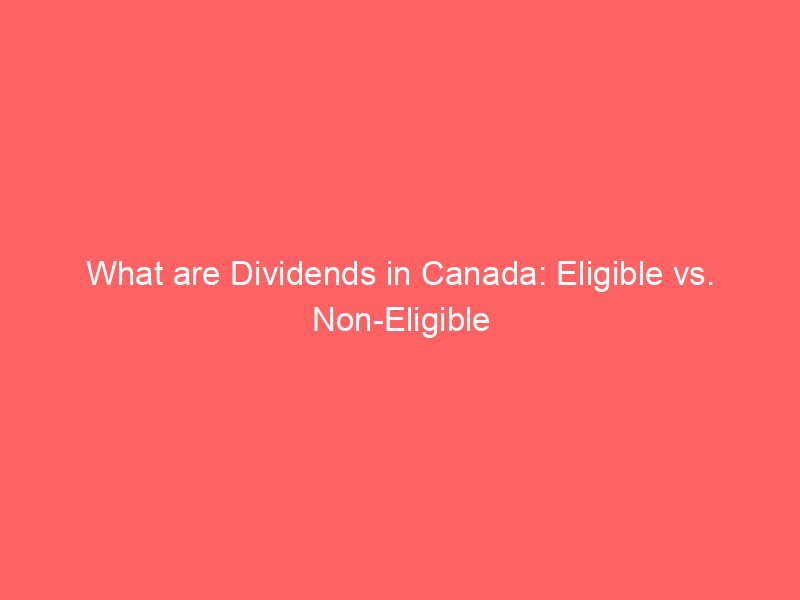Many companies pay dividends, a share of after-tax profits or investment income paid out to shareholders. In Canada, these are reported on a T5 slip and must be included in your tax return.
Looking for Sending Money Internationaly
Canadian companies can issue three kinds of dividends to their shareholders:
- Eligible Dividends
- Non-Eligible Dividends
- Capital Dividends
Each kind of dividend has a different tax treatment, which can impact your overall tax bill.
Eligible vs. Non-Eligible Dividends
Whether you’re doing corporate or personal taxes, understanding the difference between eligible and non-eligible dividends is key to good tax planning.
Tax Integration and Dividends
In Canada, different kinds of dividend income are taxed differently. The goal is tax integration, to make a dollar of income earned by a corporation the same as a dollar earned directly by a shareholder.
Corporations pay dividends after they’ve paid tax on their profits, so the income shouldn’t be taxed twice. Shareholders should only pay the balance. To prevent double taxation, Canadian corporations issue dividends with a dividend tax credit to offset the tax already paid by the corporation.
However since Canadian corporations can be taxed at different rates and may have access to deductions like the small business deduction, they issue either an “eligible” or a “non-eligible” dividend to shareholders.
Eligible dividends get preferential tax treatment at the shareholder level, with a bigger dividend tax credit and less tax on this income.
What is an Eligible Dividend?
An eligible dividend is a kind of dividend income where the corporation hasn’t received preferential tax treatment, so shareholders get a bigger dividend tax credit. These are typically issued by publicly traded companies and large private corporations that pay higher corporate tax rates.
Since these companies don’t have access to deductions like the small business deduction, their income is taxed at a higher rate. So, when the corporation issues dividends, shareholders are taxed at a lower rate.
Corporations and Eligible Dividends
Corporations issuing eligible dividends must have enough funds in their General Rate Income Pool (GRIP) and have their Low Rate Income Pool (LRIP) at zero. The GRIP balance is income taxed at a higher corporate rate, so the corporation can issue eligible dividends and give shareholders a bigger tax credit.
The LRIP includes income that has received preferential tax treatment (like deductions), so dividends paid from this pool don’t get the same preferential tax treatment as eligible dividends.
Before issuing eligible dividends, corporations must know their GRIP or LRIP balances. They must also inform shareholders that the dividends they receive are eligible so shareholders can apply the correct “gross-up” and dividend tax credits.
Individuals and Eligible Dividends
When individual shareholders receive eligible dividends, they get a bigger dividend tax credit. The dividends are “grossed up” to reflect the income earned by the corporation, and then a bigger dividend tax credit is applied to offset the tax the corporation has already paid. So, shareholders pay less tax on eligible dividends than non-eligible ones.
What is a Non-Eligible Dividend?
A non-eligible dividend is issued by companies taxed at lower corporate rates, so shareholders get a smaller dividend tax credit. These are often issued by smaller private corporations or Canadian-controlled private Corporations (CCPC) that get a lower tax rate on the first $500,000 of income.
Since these corporations have paid less tax on their income, shareholders’ dividends don’t get preferential tax treatment. So, individual shareholders get a smaller tax credit than eligible dividends.
Corporations and Non-Eligible Dividends
Smaller corporations under $500,000 generally issue non-eligible dividends. These are also “grossed up”, but only by 15% compared to 38% for eligible dividends. The dividend tax credit is also smaller, so individual shareholders pay more tax on non-eligible dividends than on eligible ones.
Eligible Dividends vs. Non-Eligible Dividends
When Canadian corporations issue dividends, it affects the corporation and the shareholder. Knowing the dividend tax implications is key to making smart decisions for your business and personal taxes.
